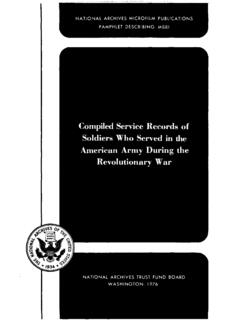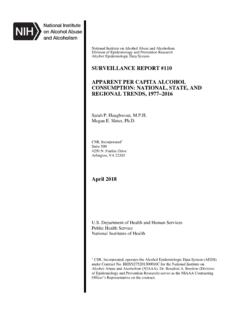Transcription of SCIENTIFIC WRITING BOOKLET Compiled by Marc E. Tischler ...
1 SCIENTIFIC WRITING BOOKLET 1 SCIENTIFIC WRITING BOOKLET TABLE OF CONTENTS General Guidelines 2-3 title abstract rules for SCIENTIFIC WRITING Using an Outline to Prepare Your Paper 3 description of an outline value of the outline developing the outline Word Usage in SCIENTIFIC WRITING 4-8 Grammar 8 Active versus Passive Voice in WRITING 9-11 when to use active voice when to use passive voice active-passive exercise WRITING the Introduction 11-12 WRITING the Methods 13-14 WRITING the Results and Discussion 14-19 results section numbers and statistics tables figures discussion section Preparing the Reference Section 20-22 examples of citation formats examples of reference formats Answers to Active-Passive Exercise 23 Sources for Further Information 24 websites book sources 2 GENERAL GUIDELINES A SCIENTIFIC paper is a written report describing original research results.
2 The format of a SCIENTIFIC paper has been defined by centuries of developing tradition, editorial practice, SCIENTIFIC ethics and the interplay with printing and publishing services. A SCIENTIFIC paper should have, in proper order, a Title, Abstract, Introduction, Materials and Methods, Results, and Discussion. Title A title should be the fewest possible words that accurately describe the content of the paper. Omit all waste words such as "A study of ..", "Investigations of ..", "Observations on ..", etc. Indexing and abstracting services depend on the accuracy of the title, extracting from it keywords useful in cross-referencing and computer searching. An improperly titled paper may never reach the audience for which it was intended, so be specific. If the study is of a particular species, name it in the title. If the inferences made in the paper are limited to a particular region, then name the region in the title. Abstract A well prepared abstract should enable the reader to identify the basic content of a document quickly and accurately, to determine its relevance to the reader's interests, and thus to decide whether to read the document in its entirety.
3 The abstract should succinctly state the principal objectives and scope of the investigation where these are not obvious from the title. More importantly, the abstract should concisely summarize the results and principal conclusions. The abstract should not include details of the methods employed unless the study is methodological, primarily concerned with methods. The abstract must be brief, not exceeding 250 words or as otherwise defined by the journal. If the essential details of the paper can be conveyed in 100 words, do not use 200. Do not repeat information contained in the title. The abstract, together with the title, must be self-contained as it is often published separately from the paper in abstracting services. Omit all references to the literature and to tables or figures, and omit obscure abbreviations and acronyms even though they may be defined in main body of the paper. Rules for SCIENTIFIC WRITING Interest, inform, and persuade the reader Write for your reader and write clearly Eliminate unnecessary redundancy Avoid digressions Don't over explain and avoid overstatement Avoid unnecessary qualifiers Use consistent tenses Use the precise word Simpler words are preferred over complex words and use concrete words and examples Simpler sentences are preferred over more complicated sentences Use the active voice (except generally in methods) Make sure the subject and verb agree Use affirmative rather than negative constructions Avoid use of the indefinite "this" Use transitions Cite sources as well as findings Proofread your paper carefully; spell check does not catch everything; "there" is spelled correctly but not if you meant "their" 3 In general, the best WRITING is simple and direct.
4 WRITING that is simple and direct is most easily understood. It also tends to be the most forceful and memorable. Use no more words than necessary and never use a complicated word if a simpler one will do just as well. Many people seem to feel that WRITING in a complicated way makes one sound serious, scholarly and authoritative. While this type of WRITING may sound serious, it is no more authoritative than WRITING that is simple and direct. Certainly, it is more difficult to understand. Often, it sounds pompous and overbearing. If your purpose is to be understood in a way that is both forceful and memorable, adopt a style that is simple and direct. USING AN OUTLINE TO PREPARE YOUR PAPER Description of an outline An outline is: A logical, general description A schematic summary An organizational pattern A visual and conceptual design of your WRITING An outline reflects logical thinking and clear classification. Value of the Outline Aids in the process of WRITING Helps you organize your ideas Provides a snapshot of each section of the paper will flow Presents your material in a logical form Shows the relationships among ideas in your WRITING Constructs an ordered overview of your WRITING Defines boundaries and groups Developing the Outline Before you begin: Determine the purpose of your paper Determine the audience you are WRITING for Develop the thesis of your paper Then: Brainstorm: List all the ideas that you want to include in your paper Summarize the question(s)/problem(s) List the key points/elements pertaining to the question(s)/problem(s) Organize: Group related ideas together.
5 Place each key point/element in a separate file Order: Arrange material in subsections from general to specific or from abstract to concrete Make sure the organizing scheme is clear and well-structured Identify the important details that contribute to each key point/element Label: Create main and sub headings Note the sources pertaining to each detail 4 WORD USAGE IN SCIENTIFIC WRITING Any glossary of word usage assumes that what is acceptable for some uses may not be for others. Some terms and expressions are worn-out clich s and have outlived their usefulness; other expressions and terms, though not incorrect, are not precise. In reporting and recording research, try to be as accurate and precise in describing it as in doing it. Avoid the ambiguous and "faddish." Use a US-English spelling checker. Make sure you use words according to the precise meaning understood by the average person. Ideally, you would check whether every word could be deleted or replaced by a better one.
6 Aim for economy: o because instead of based on the fact that; o for or to instead of for the purpose of. o there were several subjects who ; o it is suggested that a relationship may ; o both alike; one and the same; o a total of n subjects; o four different groups; o absolutely essential; o found previously; o small in size; o in close proximity; o very close to zero; o much better; o period of time; o summarize briefly; o the reason is because; o also included; o except for. Aim for precision: o patient or gymnast instead of subject; o concentration or frequency instead of level. Don t generalize unnecessarily. For example, don t say some if you know of only one instance. This on its own is an ambiguous antecedent. Use instead this test or this problem. Avoid hype (hyperbole). Words like very and extremely are usually unnecessary. Note these singular and plural forms: criterion, criteria; datum, data; medium, media; phenomenon, phenomena.
7 Don t use however or its synonyms twice in one paragraph, because changing the direction of an argument twice in one paragraph may annoy readers. Don t use however more than once every 10 paragraphs. Try a thesaurus for synonyms. Avoid the so-called non-human agent. For example, use the authors concluded rather than the study concluded Avoid colloquialisms, such as steer clear of. Avoid as such. Poor: The SCAT is a reliable test of state anxiety. As such, it is suitable for experimental studies. Better: The SCAT is a reliable test of state anxiety; it is therefore suitable for experimental studies. Avoid her, his and any other sexist language, even if the subjects are clearly of one gender. 5 Above ("the above method," "mentioned above," etc.) -- Often, you are referring to something preceding, but not necessarily above; a loose reference, convenient for writers, but not for readers. Be specific. You know exactly what and where, but your readers may have to search (sometimes through much preceding material).
8 Affect, effect -- Affect is a verb and means to influence. Effect, as a verb, means to bring about; as a noun, effect means result. All of, both of -- Just "all" or "both" will serve in most instances. Alternate, alternative -- Be sure which you mean. And (to begin a sentence) -- Quite proper. You have been told not to do this in grade school. But teacher's purpose was to keep you from using fragmentary sentences; either "and" or "but" may be used to begin complete sentences. And both are useful transitional words between related or contrasting statements. Apparently (apparent) -- means obviously, clearly, plainly evident, but also means seemingly or ostensibly as well as observably. You know the meaning that you intend, but readers may not. Ambiguity results. Use obvious(ly), clear(ly), seeming(ly), evident(ly), observable or observably, to remove doubt. Appear, appears -- Seem(s)? "He always appears on the scene, but never seems to know what to do." "Marley's ghost appeared but seemed harmless.
9 " As -- Dialectal when used in place of that or whether; do not use as to mean because or inasmuch as. At the present time, at this point in time -- Say "at present" or "now" if necessary at all. Below -- See comment about above. But (to begin a sentence) -- Go right ahead (see "And" and "However"). By means of -- Most often, just "by" will serve and save words. Case -- Can be ambiguous, misleading, or ludicrous because of different connotations; , "In the case of Scotch whiskey,.." Case also is a frequent offender in padded, drawn-out sentences. For "in this case," try "in this instance." Compare with, compare to -- Compare with means to examine differences and similarities; compare to means to represent as similar. One may conclude that the music of Brahms compares to that of Beethoven, but to do that, one must first compare the music of Brahms with that of Beethoven. Comprise -- Before misuse, comprise meant to contain, include, or encompass (not to constitute or compose) and still does, despite two now opposite meanings.
10 Use and meanings now are so confused and mixed that "comprise" is best avoided altogether. Correlated with, correlated to -- Although things may be related to one another, things are correlated with one another. Different from, different than -- Different from! Also, one thing differs from another, although you may differ with your colleagues. 6 Due to -- Make sure that you don't mean because of. Due is an adjective modifier and must be directly related to a noun, not to a concept or series of ideas gleaned from the rest of a statement. "Due to the fact " is an attempt to weasel out. During the course of, in the course of -- Just use "during" or "in." , -- Apply to no more than two items or categories. Similarly, former and latter refer only to the first and second of only two items or categories. Experience(d) -- To experience something is sensory; inanimate, unsensing things (lakes, soils, enzymes, streambeds, farm fields, etc.) do not experience anything. Following -- "After" is more precise if "after" is the meaning intended.







